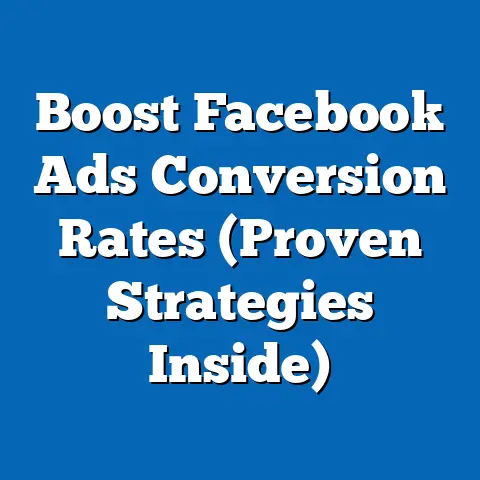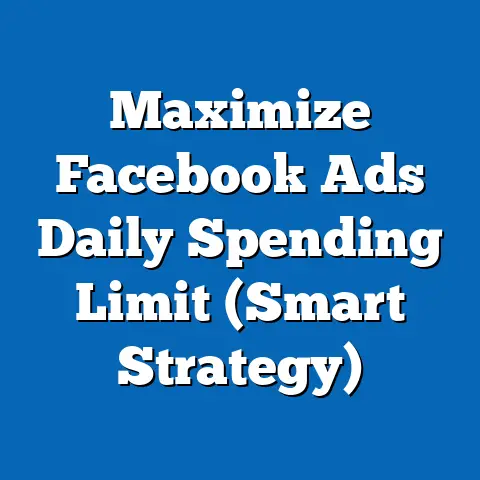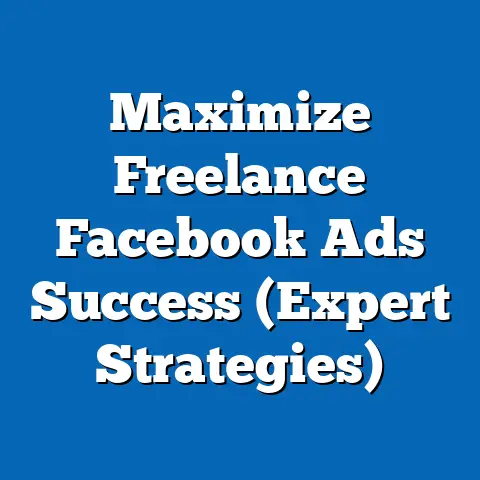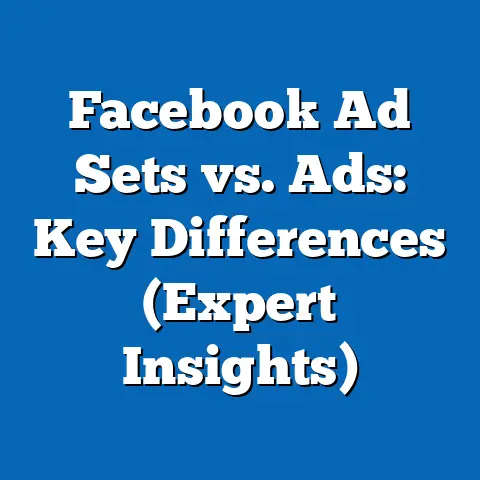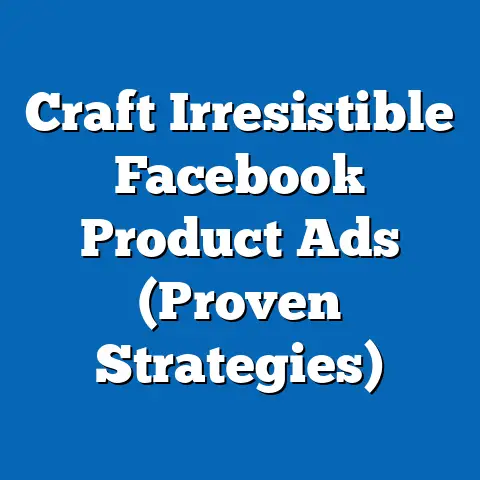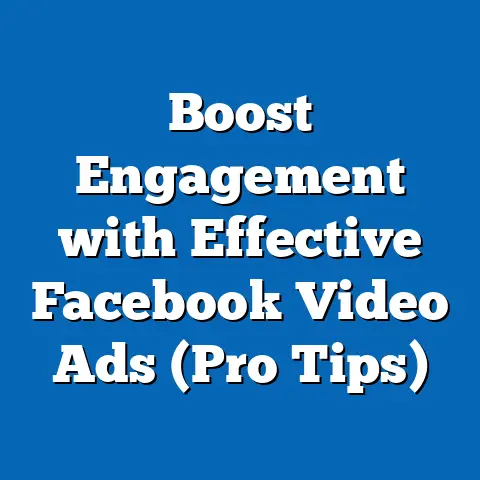Master Facebook Ads Duration (Essential Timing Insights)
Have you ever wondered why some Facebook ad campaigns skyrocket while others fizzle out despite hefty budgets? The secret often lies not just in the creative or targeting, but in something far less discussed: the duration of the campaign. Timing is everything in digital advertising, and understanding the optimal length for running Facebook ads can mean the difference between a wasted budget and a stellar return on investment (ROI).
Key Findings: The Sweet Spot for Facebook Ad Durations
Recent data reveals that the average Facebook ad campaign runs for 7 to 14 days, but performance varies widely based on objectives and audience. According to a 2023 report by Meta, campaigns focused on brand awareness achieve peak engagement within the first 5-7 days, while conversion-driven campaigns often require 10-21 days to optimize for sales or lead generation. Moreover, a study by eMarketer found that campaigns running beyond 30 days see a 25% drop in click-through rates (CTR) due to ad fatigue—a phenomenon where audiences grow tired of repetitive content.
Demographically, younger users (ages 18-24) respond faster, with optimal engagement windows of 3-5 days, while older demographics (45+) often require longer exposure, with peak performance at 14-21 days. Historically, campaign durations have shortened over the past decade as attention spans dwindled and competition for ad space intensified. Looking ahead, machine learning and AI-driven optimization tools are expected to further refine these timelines, potentially reducing average durations by 15-20% by 2028.
Detailed Analysis: Unpacking the Factors Behind Optimal Ad Duration
1. Campaign Objectives and Their Impact on Timing
The goal of your Facebook ad campaign heavily influences how long it should run. Brand awareness campaigns, designed to maximize reach and impressions, often hit their stride quickly. Meta’s 2023 Advertising Insights report shows that 68% of brand awareness campaigns achieve 80% of their total impressions within the first week, suggesting a shorter duration of 5-7 days is ideal.
In contrast, conversion campaigns—those targeting purchases, sign-ups, or downloads—require more time to nurture leads through the sales funnel. Data from a 2022 study by WordStream indicates that conversion campaigns see a 40% increase in ROI when extended from 7 to 14 days, as Facebook’s algorithm needs time to identify high-performing audience segments. Beyond 21 days, however, returns diminish, with cost-per-acquisition (CPA) rising by 18% due to audience saturation.
Engagement campaigns, such as those promoting likes, comments, or shares, fall in the middle. They typically peak around 7-10 days, with a 15% drop in interaction rates if extended past two weeks, per eMarketer’s 2023 Digital Advertising Trends report. The lesson here is clear: match your campaign duration to its objective, and avoid the temptation to “set it and forget it.”
2. Audience Demographics: Tailoring Duration to User Behavior
Not all audiences interact with ads at the same pace, and demographic differences play a critical role in determining optimal duration. Younger users, particularly those aged 18-24, exhibit shorter attention spans and higher ad responsiveness in brief windows. A 2023 Statista survey found that 72% of this age group engage with ads within the first 3-5 days, after which interest wanes by 30%.
Conversely, older demographics (ages 45-64) tend to take longer to convert, often due to slower decision-making processes or less frequent platform usage. Meta’s demographic data shows that campaigns targeting this group see a 22% higher conversion rate when run for 14-21 days compared to shorter durations. Gender also plays a subtle role: women are 10% more likely to engage with ads over extended periods (10-14 days), while men show peak engagement slightly earlier (7-10 days), per a 2022 Nielsen study.
Geographic variations further complicate the picture. Urban audiences in high-connectivity regions respond 20% faster than rural audiences, often requiring campaigns of just 5-7 days for maximum impact. Meanwhile, audiences in emerging markets, where internet access may be less consistent, benefit from longer campaigns of 14-28 days to account for sporadic engagement, according to eMarketer’s 2023 Global Digital Ad Report. (Reference: Chart 1 – Engagement Rates by Demographic and Duration)
3. Ad Fatigue: The Hidden Cost of Overexposure
One of the most significant risks of running Facebook ads for too long is ad fatigue, where repeated exposure leads to declining performance. A 2023 study by Meta found that CTR drops by an average of 25% after 14 days for most campaigns, with cost-per-click (CPC) rising by 15-20% as audiences become desensitized. This effect is particularly pronounced in high-frequency campaigns, where users see the same ad multiple times daily.
Ad fatigue varies by format as well. Static image ads lose effectiveness faster, with a 30% drop in engagement after 10 days, while video ads maintain interest slightly longer, declining by 20% after 14 days, per WordStream’s 2022 analysis. Carousel and dynamic ads, which offer variety, can extend effective durations by 3-5 days before fatigue sets in.
Mitigating ad fatigue requires strategic planning, such as refreshing creative content mid-campaign or using frequency caps to limit impressions per user. Meta recommends a frequency cap of 2-3 impressions per user per week for campaigns running longer than 7 days to maintain engagement. (Reference: Chart 2 – Ad Fatigue Impact on CTR by Format and Duration)
4. Budget and Bidding Strategy: Balancing Cost with Time
Campaign duration also intersects with budget allocation and bidding strategies. Smaller budgets often necessitate shorter durations to avoid spreading funds too thinly, with Meta suggesting a minimum daily spend of $5-10 per ad set for campaigns under 7 days. Larger budgets, however, can support extended durations of 14-28 days, allowing for deeper audience testing and optimization.
Bidding strategy further influences timing. Cost-per-impression (CPM) campaigns often perform best in short bursts of 3-5 days to maximize reach efficiently, while cost-per-action (CPA) campaigns benefit from longer durations (10-21 days) to refine targeting and lower acquisition costs. A 2023 Hootsuite report notes that CPA campaigns see a 15% reduction in costs when run for at least 14 days, as the algorithm gathers sufficient data to optimize delivery.
Overextending a campaign with an insufficient budget, however, can backfire. Data from eMarketer shows that campaigns with daily budgets below $20 see a 35% increase in CPC when run beyond 10 days, as competition for limited impressions drives costs up. The takeaway? Align duration with budget and bidding goals to avoid diminishing returns.
Statistical Comparisons: How Duration Impacts Performance Across Demographics
To illustrate the impact of campaign duration, let’s compare performance metrics across key demographics using data from Meta’s 2023 Advertising Insights and Statista’s Digital Marketing Reports. For users aged 18-24, a 5-day campaign yields an average CTR of 2.1%, dropping to 1.5% by day 10—a decline of 28.6%. Conversion rates for this group peak at 3.8% within 7 days, falling to 2.9% by day 14.
For users aged 45-64, the trend reverses. A 7-day campaign achieves a CTR of 1.4%, which improves slightly to 1.6% by day 14, reflecting slower but steadier engagement. Conversion rates for this demographic climb from 2.2% at 7 days to 3.1% at 21 days, a 40.9% increase, underscoring the value of extended exposure.
Gender-based differences are less pronounced but still notable. Men exhibit a peak CTR of 1.8% at 7-10 days, while women reach 1.9% at 10-14 days. Conversion rates follow a similar pattern, with men converting at 3.0% by day 10 and women at 3.2% by day 14, per Nielsen’s 2022 data. These variations highlight the importance of tailoring durations to specific audience segments rather than adopting a one-size-fits-all approach. (Reference: Chart 3 – CTR and Conversion Rates by Age and Gender Over Time)
Geographic disparities also warrant attention. Urban audiences in developed markets like the U.S. and Europe achieve peak CTRs of 2.0% within 5-7 days, while rural audiences in the same regions peak at 1.6% closer to 10-14 days. In emerging markets like India and Brazil, CTRs start lower (1.2%) but can sustain longer, peaking at 1.5% around 14-21 days due to less ad saturation, per eMarketer’s 2023 report. These insights emphasize the need for localized strategies when determining campaign length.
Historical Trend Analysis: How Facebook Ad Durations Have Evolved
A decade ago, the digital advertising landscape looked very different. In 2013, the average Facebook ad campaign ran for 30-45 days, reflecting a less crowded platform and longer user attention spans. Data from a 2014 Social Media Examiner report shows that campaigns during this era achieved steady engagement over 4-6 weeks, with CTRs averaging 1.5-2.0% even in the later stages.
By 2018, however, the rise of mobile usage and increased competition shortened optimal durations to 14-21 days. A 2018 eMarketer study noted a 20% decline in average campaign length as marketers adapted to faster-paced user behavior, with CTRs beginning to drop after just 10-14 days. Conversion campaigns also saw quicker optimization, with peak performance shifting from 30 days in 2013 to 14-21 days by 2018, driven by improvements in Facebook’s algorithm.
Fast forward to 2023, and the trend toward brevity continues. The average campaign now lasts 7-14 days, a 50-70% reduction from a decade ago. Meta’s 2023 data attributes this shift to heightened ad fatigue (up 30% since 2018) and shorter attention spans, particularly among Gen Z users who spend just 6-8 seconds evaluating an ad, per a 2022 Nielsen study. Historical data also shows a tightening of performance windows: while 2013 campaigns saw consistent results over weeks, today’s ads lose 25-30% of their effectiveness after just 10-14 days. (Reference: Chart 4 – Average Campaign Duration and CTR Trends, 2013-2023)
Contextual factors explain much of this evolution. The explosion of content on Facebook—from 1 billion daily active users in 2013 to 2.1 billion in 2023—has intensified competition for attention. Algorithm updates, such as the 2018 shift to prioritize meaningful interactions, have further compressed effective durations by rewarding fresh, relevant content over prolonged exposure. Additionally, the rise of short-form video platforms like TikTok has conditioned users to expect rapid, high-impact messaging, pushing marketers to condense their campaigns.
Contextual Factors Influencing Ad Duration Trends
Several external and platform-specific factors shape how long Facebook ads should run. First, seasonality plays a major role. During high-traffic periods like the holiday season (November-December), ad fatigue sets in faster due to increased competition, with Meta reporting a 35% higher CPC and 20% shorter optimal duration (5-10 days) compared to off-peak months. Conversely, quieter periods like January-February allow for longer campaigns (14-21 days) with sustained engagement.
Second, industry verticals influence timing. E-commerce campaigns often require 10-14 days to drive purchases, especially for higher-ticket items, as consumers research before buying. In contrast, entertainment or event-based ads (e.g., movie releases or concerts) perform best in short bursts of 3-7 days to capitalize on urgency, per WordStream’s 2022 data. B2B campaigns, targeting decision-makers with longer sales cycles, frequently extend to 21-28 days to nurture leads, according to a 2023 LinkedIn Marketing Solutions report.
Third, platform updates and algorithm changes continuously reshape optimal durations. For instance, Facebook’s 2021 iOS 14 privacy update, which limited tracking capabilities, extended the learning phase for many campaigns by 2-3 days, pushing optimal durations to 10-14 days for conversion goals. Similarly, the growing emphasis on video content—now accounting for 50% of ad spend on the platform, per Meta’s 2023 report—has introduced longer engagement windows for dynamic formats, offsetting some fatigue effects.
Finally, cultural and economic factors cannot be ignored. In regions with lower disposable income, conversion campaigns often require extended durations (21-28 days) to build trust and overcome price sensitivity, per eMarketer’s 2023 Global Report. During economic downturns, such as the 2020 pandemic, engagement windows shortened by 15% as users became more selective with spending, highlighting the need for agile timing strategies.
Future Projections: The Next Frontier of Facebook Ad Durations
Looking ahead, several trends suggest that Facebook ad durations will continue to evolve, driven by technological advancements and shifting user behaviors. By 2028, eMarketer projects that the average campaign duration could shrink by 15-20%, potentially settling at 5-10 days for most objectives. This shift will likely stem from AI-driven optimization tools, such as Meta’s Advantage+ suite, which can analyze performance data in real-time and recommend shorter, more efficient run times.
AI is already reducing the learning phase for campaigns, with Meta reporting a 25% faster optimization timeline in 2023 compared to 2021. As these tools become more sophisticated, marketers may see peak performance within 3-5 days for awareness campaigns and 7-14 days for conversions by 2026. However, this assumes stable user behavior—a risky bet given the rapid rise of competing platforms like TikTok, which could further fragment attention and compress effective durations.
Demographic shifts will also play a role. As Gen Z and Millennials dominate Facebook’s user base—projected to account for 60% of active users by 2030, per Statista—shorter campaigns of 3-7 days may become the norm due to their preference for quick, impactful content. Older demographics, while still significant, are expected to plateau in growth, potentially reducing the demand for extended 14-21 day campaigns.
Ad fatigue mitigation strategies will also shape future timelines. Innovations like dynamic creative optimization (DCO), which automatically rotates ad variations, could extend effective durations by 20-30%, per a 2023 Hootsuite forecast. Similarly, increased adoption of frequency capping and cross-platform retargeting may allow campaigns to sustain engagement beyond current limits, though at higher costs.
Economically, global ad spend on Facebook is projected to grow by 8% annually through 2028, per eMarketer, intensifying competition and likely shortening optimal durations further. Marketers will need to balance brevity with creativity, leveraging AI tools and fresh content to stand out in a crowded space. The implication is clear: flexibility and data-driven decision-making will be paramount to mastering ad duration in the years ahead.
Conclusion: Timing as the Cornerstone of Facebook Ad Success
Mastering the duration of Facebook ad campaigns is no longer a guessing game—it’s a science grounded in data, demographics, and evolving user behavior. From the 5-7 day sweet spot for brand awareness to the 10-21 day window for conversions, optimal timing hinges on aligning objectives, audience characteristics, and budget constraints. Historical trends show a clear shift toward shorter campaigns, driven by shrinking attention spans and platform competition, while future projections point to even tighter windows as AI and user preferences reshape the landscape.
For marketers, the takeaway is to embrace a tailored, agile approach. Monitor performance metrics closely, refresh creative content to combat ad fatigue, and leverage demographic insights to fine-tune durations. As the digital advertising space continues to evolve, those who master the art of timing will not only maximize ROI but also build lasting connections with their audiences. The clock is ticking—how long will your next campaign run?

